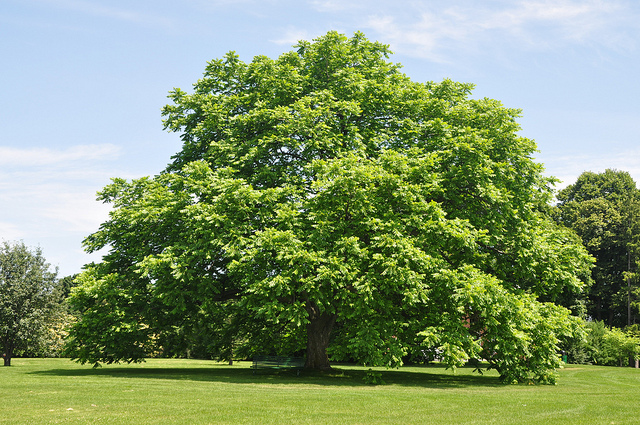Highlights include articles on Columbus’ mosquitoes, a 25-year update on the Glen Echo stabilization plan, plans for restoring the Glen Echo mural, and how to control invasive lesser celandine.
Highlights include articles on Columbus’ mosquitoes, a 25-year update on the Glen Echo stabilization plan, plans for restoring the Glen Echo mural, and how to control invasive lesser celandine.
By Alice Waldhauer

Late in 2009, the City of Columbus planted 18 butternut (white walnut) saplings within and near Glen Echo Park as part of restoration efforts following sewer line work known as the Beulah Trunk Line Rehabilitation. The City planted many other trees too, but the butternut planting caught my attention because of the threatened status of that species, Juglans cinerea. The butternut tree was the subject of an article in Ravinia in the Fall 2010/Winter 2011 issue of our newsletter. Preparation of that article led me to contact Dr. Dale Bergdahl, then of the University of Vermont as he studied butternut trees, and problems associated with a devastating canker that has decimated over 80% of the population of butternut trees.
Since that time, I have been monitoring the butternut trees; periodically checking on them to see how they are faring in Glen Echo Ravine. As of 2015, each of the butternut trees within Glen Echo Park have succumbed to the vagaries of city living; either mowed down with turf grass or washed out during stormwater that surges through the Park with some regularity. But one of the butternut trees continues to thrive on private property east of the Park in a short segment of Glen Echo Ravine located between Silver Drive and the railroad tracks.
There have been some threats to the survival of this particular tree since 2009. In April 2013, I drove by the site on my way to deliver a few morel mushrooms to a friend near Glen Echo Ravine and noticed a water-line break just above the planting spot. This was a big break, with enough force to lift a manhole cover off of its mooring, and water gushed into an adjacent catch basin and also directly down the steep ravine slope. By the next morning, heavy equipment was mobilized to the site for repairs. Fortunately, the excavation barely missed the root system of this butternut tree, but it wasn’t known whether fill material used to cover the excavation area would bury the tree alive as it eroded and slumped down the ravine slope.
This sole remaining butternut tree is nearly tall enough to be seen from the freeway. During my last visit in September 2015, the tree was about 15 feet tall and foliage on spreading branches was green and vibrant due to a cool and wet summer. It may be another decade before the tree is old enough to bear nuts, and I hope to be there to sample some.
Join Friends of the Ravines in collecting signatures to present to Columbus City Council in support of a Ravine Protection Ordinance. You can email us at friendsoftheravines @ gmail.com to show your support, or download the PDF form and gather signatures to add to our collection.
Columbus ravines have taken a beating lately. One disappeared forever. Let’s urge city council to make ravine protection a priority.
Part of Bill Moose Ravine in Clintonville, at 5132 N. High Street, was destroyed to make way for a Raising Canes fast food restaurant.
FLOW learned about the situation from a community member just a few days ago (7/23/14), and by then it was too late to try to do anything to protect the ravine from being destroyed.
We are not sure if FLOW, or the community, could have done anything to protect the ravine, but we will never know. This is a significant loss of green space, wildlife habitat, and storm water protection for our community.
Below are some pictures of the site taken today, Sunday 7/27/14. The pictures do not even come close to showing the scale of destruction to the ravine. The ravine slope in the pictures below appears very small, it is actually about 40 ‘feet’ high and hundreds of feet long.
(above pic) – Ravine slope is about 40 feet high. The tree stumps were old growth trees that were 2-3 feet in diameter.
(Above pic) – Graceland Bob Evan’s in the background. The picture makes the ravine slope look small, the slope is actually about 40 feet high, it’s a significant loss of wildlife habitat, green space, and storm water run off protection for our community.
(Above Pic) – Many old growth trees were destroyed. These trees provided habitat for wildlife and helped prevent storm water runoff. The scale of these pictures makes the trees look small. These trees were about 2-3 feet in diameter, and some of the trees were about 3-5 feet in diameter.
The slope in the above picture is about 40 feet high – all trees, shrubs, plants, and habitat have been destroyed. The broken tree stump in the background was roughly a 5 feet diameter old growth tree.